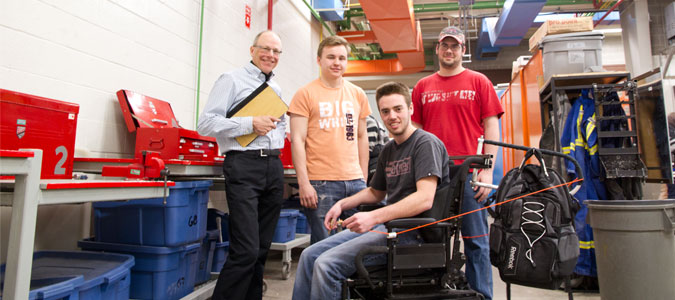Engineering for life
Rick Retzlaff’s assignment for students in his second-year Introduction to Engineering Design class this term is giving them real engineering experience, but it could also change the life of a man who uses a wheelchair.
By Kris Foster The instructor and class co-ordinator came up with the assignment after connecting with the Tetra Society of North America, a volunteer organization dedicated to developing assistive devices to enhance the lives of people with disabilities. As Retzlaff tells it, Tetra brings together "people who really like to build stuff with people who need stuff." When he heard about the organization, his first thought was, "this would make a great student project."
The instructor and class co-ordinator came up with the assignment after connecting with the Tetra Society of North America, a volunteer organization dedicated to developing assistive devices to enhance the lives of people with disabilities. As Retzlaff tells it, Tetra brings together "people who really like to build stuff with people who need stuff." When he heard about the organization, his first thought was, "this would make a great student project."
Through Tetra, Retzlaff was teamed up with Eric, a young office worker in Vancouver who is looking for a device that would enable him to easily access his backpack while in his wheelchair. In January, Retzlaff and his students watched a video about Eric and then met him via Skype for a question and answer session. Eric explained to the students his physical limitations, the problem he needed solved (he cannot get his backpack onto his shoulders and when it is there, he cannot retrieve it) and how much he was willing to spend. "This is very much client driven," said Retzlaff, "which is as it should be in engineering."
The students, who were universally enthusiastic about the challenge, were divided into 17 teams and given the task of coming up with possible backpack retrieval devices, evaluating them, doing drawings and then building a prototype in the college's fabrication lab. And they will do it all for marks. Retzlaff said their grade will also factor in how well they use the design process, a written report, a presentation and a question period about the design.
"This is hands-on experiential learning," he said. "We haven't had a fabrication component in the curriculum for a lot of years but it's a big thing. It teaches them accountability in design through building, testing and demonstrating."
The students went to work. Retzlaff observed that "the majority were thinking of some kind of swing arm," but there were also ideas involving ropes, pulleys and even drawers under the wheelchair seat. Then, when he looked at the students' initial ideas, "three-quarters were unbuildable. I had to be a little blunt but they're thanking me for it now."
As the designs developed and the prototypes took shape, Retzlaff spent a lot of time shopping for the bits and pieces the students needed for their projects with support from the various sponsors of the "fab lab"—the potash company Mosaic, Rona and The Bolt Supply Company.
In addition to being an exciting project for both instructor and students—"if this is not fun, we're doing something wrong," said Retzlaff—the class has a point to prove. Retzlaff said a senior design group at the University of British Columbia took on Eric's challenge but was unable to come up with a solution.
By mid-March, the rush was on to complete the prototypes because Eric was scheduled to visit the college March 25 to meet the students, hear their presentations and test their prototypes. There will be independent judges on hand to rate the student presentations but "nobody has quite as much stake in this as Eric does," said Retzlaff. "He is the ultimate judge."
(Unfortunately, this issue of On Campus News went to the printer before all of the prototypes were evaluated.)
No matter what the outcome, Retzlaff believes the partnership with Eric and Tetra has had an enormous benefit for the students. The experience of working through the process from concept to prototype helps them understand "there's more to engineering than just a good idea."
It is also an opportunity for them to think a bit differently, he said. Most engineering students "are not very good at broad creative thinking so when they have blinders on or are thinking in a linear way, I encourage them to think about chickens." What Retzlaff means is they should come at a challenge from a totally different angle, and that imagining chickens as part of the solution stimulates creative thinking.
"There's no engineering problem that can't be solved with chickens."

